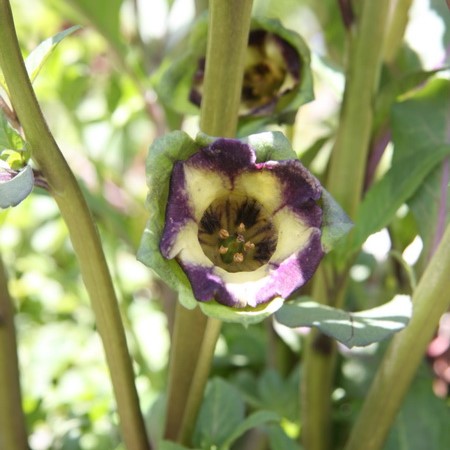Anisodus tanguticus
Overview
| Genus | Anisodus |
| Species | tanguticus |
| Common Name | - |
| Abbreviation | A. tanguticus |
| Ploidy | Diploid |
| Chromosome Number | 2n = 48 |
| Genome Size | 1250 Mb |
| Genome Assemblies | 2 |
| Cross Reference | NCBI taxon: 243964 |
Organism Image

Description
Anisodus tanguticus is a species of flowering plant belonging to tribe Hyoscyameae of subfamily Solanoideae of the nightshade family Solanaceae. It is thus closely related to Henbane and Deadly Nightshade. Solanaceae is a plant family which includes many important agricultural plants such as the potato and the tomato. It is mostly found growing in the Qinghai-Tibetan Plateau. A. tanguticus is collected and used mostly for its medicinal effects caused by the plant's biologically active nicotine and tropane alkaloids. It has a significant impact in China as one of the 50 fundamental herbs used in traditional Chinese medicine.
Whole Genomes
Whole Genome Sequences & Annotations for Anisodus tanguticus
S genes
Anisodus tanguticus 'KB-2021 (Isolate)' ASM3450975v1 S genes
| Query | Chromosome | Size(bp) | Coordinates | BLASTn Hit | BLASTn %ID | Domain |
| SLF18 | CM067539.1 | 66,055,861 | 35081440-35080310 | Solanum tuberosum DM8.1, SLF18-2 | 82.4 | F-box domain |
| SLF15 | CM067542.1 | 59,883,671 | 4216154-4217392 | Solanum tuberosum DM8.1, SLF15 | 82.6 | F-box domain |
Downloads
The Anisodus tanguticus S gene sequences are available in FASTA format.
| CDS and Protein (FASTA file) | S-gene_Anisodus_tanguticus |
Publications
NCBI BioProject PRJNA1018692. Anisodus tanguticus Genome sequencing and assembly.
Yang J, Wu Y, Zhang P, Ma J, Yao YJ, Ma YL, Zhang L, Yang Y, Zhao C, Wu J, Fang X, Liu J. Multiple independent losses of the biosynthetic pathway for two tropane alkaloids in the Solanaceae family. Nat Commun. 2023 Dec 20;14(1):8457. doi: 10.1038/s41467-023-44246-3.
Song Y, Huang JP, Wang YJ, Huang SX. Chromosome level genome assembly of endangered medicinal plant Anisodus tanguticus. Sci Data. 2024 Feb 2;11(1):161. doi: 10.1038/s41597-024-03007-7.